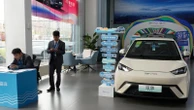Students and teachers experience the challenges of climate change firsthand, including struggles with extreme heat exacerbated by poor air quality and ventilation, and more and more missed days due to heatwaves and wildfire smoke. All harm student performance and make it harder to learn.
A newly coalescing coalition of school districts, teachers, and nonprofits see a solution available to all schools, one that can not only alleviate these inconveniences, but also address inequalities and funding shortfalls and upgrade our crumbling schools. Half the nation’s elementary schools are over a half-century old, with near-failing maintenance scores from the American Society of Civil Engineers.
Taking advantage of the IRA
By tapping into funding sources and incentives found in the Inflation Reduction Act and Investment Infrastructure and Jobs Act, schools can obtain downpayments for all manner of infrastructure investments that can help them improve their resiliency and save money. Organizations such as Undaunted K12 are pushing schools to take advantage of the nation’s largest clean energy investment.
For instance, the Treasury Department estimates K-12 schools spend $8 billion annually on energy bills alone; advocates argue that tapping into IRA renewable energy programs to install solar panel or geothermal heating systems, schools can make sure more of their money gets redirected from utility profits to other school budget priorities. A district in Batesville, Arkansas, for instance, saved so much with solar that it was able to raise teacher pay.
The IRA and Infrastructure Bill offer numerous ways to retrofit buildings and add renewable energy. There are incentives to turn former blacktop playgrounds into grassy play spaces, and invest in retrofits or HVAC systems to improve energy efficiency and air quality. The IRA, for instance, covers 30% of the cost of solar panel installation to lower energy bills—already in use at more than 8,000 U.S. schools—as well as a $5 billion pool of money for electric school buses (U.S public schools operate 480,000 buses nationally).
‘This is a once-in-a-lifetime opportunity for our schools’
Heather Dietzel, Milwaukee Public School’s Facilities and Maintenance sustainability project manager, says schools in her district are applying for every benefit they can get. For instance, the district has roughly 142 school sites mostly covered in asphalt, which reflects heat, increases the urban heat island effect, and prevents stormwater drainage. Dietzel’s team, together with local nonprofit Reflo, is applying for IRA funding to help rip up that asphalt and add grass and plants to improve climate resiliency.
Kat Klawes, a former teacher in Wisconsin and Flint, Michigan, now serves as a climate coordinator for Citizen Action of Wisconsin, and has worked with teachers across southeastern Wisconsin on applying for grants for solar panels, HVAC, heat pumps, and other projects.
“I feel like the inflation Reduction Act and the Justice 40 initiative is one of the biggest steps we have taken in decades to address inequality in our schools,” Klawes said, referring to the IRA pledge to direct 40% of funding to disinvested communities. “This is a once-in-a-lifetime opportunity for our schools.”
While the IRA passed in 2022, it has taken months of rulemaking and regulatory work by the government to finalize how these benefits and tax breaks would work. Many potential benefits have really only been open for application for the last six months, Klawes said, and many schools and educators still aren’t aware of what’s available and possible.
It’s too early to have any comprehensive numbers of how many schools have applied, and for how much. But advocates expect the final tally to be quite high. Since many of the benefits are uncapped, meaning they’re available to whoever qualifies, and last until 2032, schools still have years to plan, apply and build
According to some of the teachers, administrators, and advocates involved, action toward taking advantage of these benefits is accelerating, especially after a system of direct pay for institutions like schools has been established. Klawes added it was important that all schools have the resources to apply for and administer grants, since these awards can sometimes be disproportionately won by districts with more resources.
Other schools that have already invested in these kinds of renewable efforts, such as the newly opened Forest Edge Elementary in Dane County, Wisconsin, which already runs on solar and geothermal and will apply for rebates that will fully pay for the green energy systems.
Adding solar power
In Las Vegas, Elizabeth Becker, a former teacher turned IRA Campaign Coordinator for the Progressive Leadership Alliance of Nevada, is pushing to upgrade the Clark County School District’s solar power setup. Currently, just 42 out of 386 schools in the district, the fifth largest in the U.S., have any solar capacity, and many have smaller arrays, just 100 kilowatts. Becker is seeking funding to get all schools to have 500kW to 1MW arrays, helping to cut some of the district’s $120 million energy bill, and redirect that funding into other school needs. With the acres and acres of parking lots and school roofs that could be covered with solar panels, Becker believes aggressive installation could ideally cover the school’s energy needs and free up money for other longstanding challenges.
“There’s so much deferred maintenance that needs to get done, we’re always putting out fires,” said Becker. “This can help fix that problem.”
Dietzel says some of the teachers working on these efforts are personally motivated, but many have also been inspired by students expressing their own anxiety about climate change, and asking about what’s being done to help—specifically at their schools. It helps that her district has been very upfront about climate issues, passing a climate justice resolution in 2020 that pushes for more action and adaptation.
New teaching tools
“Our number one goal with this is a better student experience,” said Dietzel. “And, if students can see us doing the work of climate change mitigation, then they’ll be better prepared for those kinds of jobs, and to take over from us someday.”
Many teachers see these infrastructure investments–new solar panels, or green school yards—as not just needed upgrades, but teaching tools to help with lessons about the environment, energy, and sustainability. Dietzel sees it as walking the walk, and helping kids learn about these issues.
“I think that some people think that kids don’t hear what’s going on, don’t feel the heat, and they don’t notice that they’ve had school canceled because the school classrooms are too hot,” said Dietzel. “They all know, and they hear what’s going on, and they see the adults maybe not responding with the urgency that they would expect.”










No comments